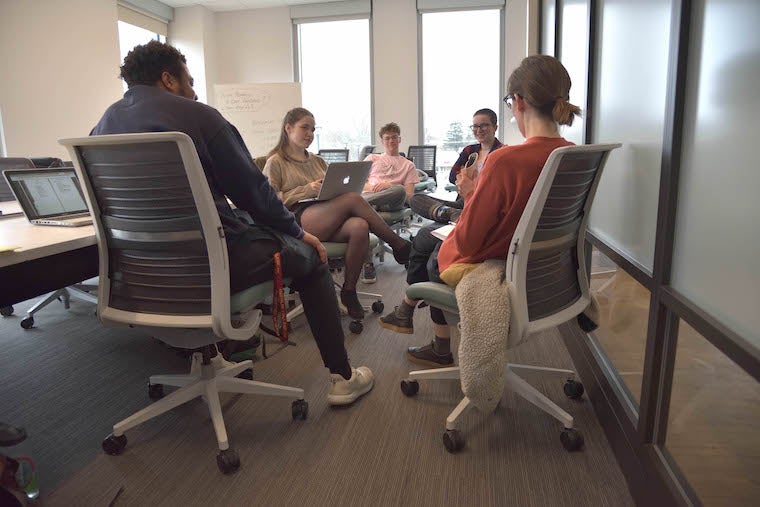Philosophy in the Schools: Learning Through Teaching
July 11, 2019
Phoebe Pan ’20

Philosophy in the Schools classroom in StudiOC.
Photo credit: Michael Hartman
Among the hundreds of offerings in the spring 2019 catalog, one course in particular has proved to be a demanding yet richly rewarding undertaking: Philosophy in the Schools Practicum, or PHITS Practicum for short.
The course, taught by Associate Professor of Philosophy Katherine Thomson-Jones, is a community-based learning course. Students improve their philosophical skills and comprehension through outreach, by visiting neighboring Eastwood Elementary twice a week and leading discussions with first and second graders. The aims of the course are wide-reaching, from building essential philosophical skills at an early age to allowing college students to apply what they’re learning in a practical manner, even with something as abstract as philosophy.
The PHITS Practicum is structured in several layers throughout a given week. First, the college students meet in the Oberlin Center for Convergence (StudiOC) for seminar discussions of particular philosophical topics and readings. After having digested the topics, the students prepare to translate complex ideas for the elementary school kids, in order to guide them through the same philosophical issues. Then, at Eastwood, the college students are divided into small groups per classroom, where they lead discussions that result in questions, reflections, and written work.
“Essentially, the college students are learning by teaching, but it’s a very student-centered type of teaching,” says Thomson-Jones. “The college students are just trying to be facilitators, while allowing the elementary school kids to have their own discussions and practice certain skill sets, such as listening well, giving reasons for things, and thinking critically when they agree or disagree.”

Photo credit: Michael Hartman
Thomson-Jones, now in her second year of teaching the course, notes that both college and elementary school students have much to learn from each other. “It struck me that kids are natural philosophers, and they love to think about big questions. Some questions—such as, Where are numbers? Are they written down on a page, or are they in my head?—might sound weird to an older student. But to the younger students, everything’s open and new for them. I think that college students can harness that curiosity and openness in their own studies.”
Creative writing and visual arts major Jack McMillin ’20, who took the course last year and is now a teaching assistant for it this semester, expresses how PHITS has impacted the ways he thinks about education.
“It consistently challenges students and myself to reevaluate how we learn, and then use this as a basis for facilitating meaningful discussions. The course has really helped solidify different approaches to pedagogy by teaching how to communicate coherently and fluidly, while moving back and forth between different educational settings.”
The course is also enriched by StudiOC, as PHITS is a part of the Art of Teaching and Learning cluster, along with two other courses taught by Associate Director of Bonner Center Curricular Initiatives Tania Boster and Professor of Music Education Jody Kerchner. StudiOC allows for cross- and interdisciplinary programming that includes lectures, group projects, and collaborative research. One of the advantages of interdisciplinary programming is how it generates fresh perspectives and approaches to shared themes across studies.
“There’s a historical research-based approach, an education theory approach, and a philosophical approach,” says Thomson-Jones. “It’s inspiring to see what people of different disciplines are all doing with the same themes of education and learning through teaching.”
You may also like…
Josh Nolan Named Vice President, General Counsel, and Secretary at Oberlin
Distinguished attorney brings extensive experience in higher education law.
Learning by Teaching: Oberlin Students Share Global Music with Young Learners
College and Conservatory students in PACE 103 prepare local children for an immersive community concert at Oberlin.
Nuiko Wadden ’02 Joins Oberlin Conservatory Faculty as Assistant Professor of Harp
The versatile musician brings extensive opera, orchestral, and contemporary music experience to her role


